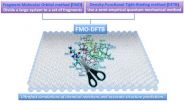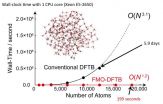(Press-News.org) Nagoya, Japan - Professor Stephan Irle and Yoshio Nishimoto at the Institute of Transformative Bio-Molecules (ITbM) of Nagoya University and Dr. Dmitri Fedorov of the National Institute of Advanced Industrial Science and Technology (AIST, Tsukuba) have developed a novel ultrafast quantum chemical method enabling rapid simulations of molecules containing more than a million atoms without detrimental loss in accuracy. This method consists of a combination of the Fragment Molecular Orbital (FMO) approach and the Density-Functional Tight-Binding (DFTB) method, called FMO-DFTB and has successfully evaluated large molecules including polypeptides, a DNA segment, a small protein and a fullerite surface. The study, published online on September 22, 2014 in the journal, Journal of Chemical Theory and Computation, demonstrates a new quantum mechanical computational method achieving rapid and efficient simulation of complex molecular systems consisting of thousands to a million atoms. Simulations using FMO-DFTB could be performed on small-scale PC clusters including desktop computers, which would be useful for biologists, chemists and material scientists investigating the reactivity and structure of complex molecular systems.
Many molecular systems encountered in biochemistry and nanoelectronics contain a large number of atoms, usually in the order of 10^3 to 10^7. Computational efforts required for quantum mechanical simulations of such systems increases steeply with the size of the system. For example, if a molecular system size increases by a factor of 100, this can result in the computational cost to be a million to a 100 trillion times more expensive depending on the method used. Therefore, simulations of large molecular systems usually require high computational expenses (computational efforts and memory requirements) and long simulation times, leading to a high demand for a rapid and accurate method to deal with such systems. The DFTB method is a semi-empirical quantum mechanical approach, which has been applied to various organic and biological systems. "Although the DFTB method is relatively fast, the computational effort increases cubically with respect to the system size. Therefore, we envisaged to combine DFTB with another approach to develop a method that can perform efficient quantum chemical calculations of complex molecular systems," says Prof. Stephan Irle, who led the research. Irle's group focused on the FMO approach, which divides complicated system into molecular fragments and has been applied to a variety of biological and inorganic systems. "By the novel combination of DFTB and FMO, we developed a unique method called FMO-DFTB, which enables ultrafast simulations with negligible error," describes Prof. Irle. Upon subjecting a water cluster system containing up to about 20,000 atoms to FMO-DFTB, the energy calculations took about 3 minutes whereas the corresponding full DFTB calculation is estimated to require about 3 weeks, which is about 10,000 times longer than FMO-DFTB. "With a nearly linear scaling of computational effort with respect to system size by the FMO-DFTB method, we have achieved a huge improvement over the DFTB approach," says Prof. Irle.
The FMO-DFTB method has also demonstrated its applicability by successfully performing geometry optimization of a fullerite cluster containing more than a million atoms, which is believed to be one of the largest quantum mechanical calculations conducted up to now. "With the development of FMO-DFTB, simulations of complex molecular systems that once required supercomputers could be potentially performed on a single desktop computer, which would be useful for many people working in the fields of molecular science, along with computational theoretical scientists," says Prof. Irle. "We are currently working to further develop the accuracy of FMO-DFTB, which could be used to look into artificial peptides developed at ITbM and to explore reactions that could not have been imagined before," elaborates Prof. Irle. FMO-DFTB is considered to enable rapid simulations of large systems that were previously impossible due to high computational effort and memory requirement. Applications of FMO-DFTB are expected to extend in various areas, from chemical systems to predict reaction mechanisms pathways and biological systems to analyze ligand-protein interactions, to nanoelectronics to study the electron transport of electronic materials.
INFORMATION:
This article "Density-Functional Tight-Binding Combined with the Fragment Molecular Orbital Method" by Yoshio Nishimoto, Dmitri G. Fedorov, and Stephan Irle is published online on September 22, 2014 in the Journal of Chemical Theory and Computation.
J. Chem. Theory Comput., 2014, Vol. 10, pages 4801 - 4812. Selected as a cover picture.
DOI: 10.1021/ct500489d
*For those interested in using this method, FMO-DFTB will be available in the next release of GAMESS-US (General Atomic and Molecular Electronic Structure System), a free software for quantum chemistry calculations. GAMESS/FMO has several GUI programs, assisting data processing for large-scale simulations using FMO methods.
About WPI-ITbM
The World Premier International Research Center Initiative (WPI) for the Institute of Transformative Bio-Molecules (ITbM) at Nagoya University in Japan is committed to advance the integration of synthetic chemistry, plant/animal biology and theoretical science, all of which are traditionally strong fields in the university. As part of the Japanese science ministry's MEXT program, ITbM aims to develop transformative bio-molecules, innovative functional molecules capable of bringing about fundamental change to biological science and technology. Research at ITbM is carried out in a "Mix-Lab" style, where international young researchers from multidisciplinary fields work together side-by-side in the same lab. Through these endeavors, ITbM will create "transformative bio-molecules" that will dramatically change the way of research in chemistry, biology and other related fields to solve urgent problems, such as environmental issues, food production and medical technology that have a significant impact on the society.
Author Contact
Professor Stephan Irle
Institute of Transformative Bio-Molecules (WPI-ITbM), Nagoya University
Furo-Cho, Chikusa-ku, Nagoya 464-8601, Japan
TEL: +81-52-747-6397 FAX: +81-52-788-6151
E-mail: sirle@chem.nagoya-u.ac.jp
Media Contact
Dr. Ayako Miyazaki
Institute of Transformative Bio-Molecules (WPI-ITbM), Nagoya University
Furo-Cho, Chikusa-ku, Nagoya 464-8601, Japan
TEL: +81-52-789-4999 FAX: +81-52-789-3240
E-mail: press@itbm.nagoya-u.ac.jp
Nagoya University Public Relations Office
TEL: +81-52-789-2016 FAX: +81-52-788-6272
E-mail: kouho@adm.nagoya-u.ac.jp
PROVIDENCE, R.I. [Brown University] -- A "Viewpoint" published in JAMA urges readers to be patient with the new federal Open Payments Program database. The site, designed to report drug and device industry payments to physicians, debuted substantially incomplete, the authors wrote, but it is too important to dismiss before its shortcomings are addressed.
"Viewed in the abstract, the value inherent in the transparency offered by the OPP database is beyond dispute," wrote Dr. Eli Y. Adashi, former dean of medicine and biological sciences at Brown University, and Sachin ...
A research team led by physicists at the University of Wisconsin-Milwaukee (UWM) has proven a method that makes it possible to find the atomic structure of proteins in action by producing "snapshots" of them with unprecedented spatial and temporal resolution.
What made it possible were the ultra-short X-ray pulses of a Free Electron Laser (XFEL).
Physics professor Marius Schmidt and doctoral student Jason Tenboer recently completed the experiment with the XFEL at the Stanford Linear Accelerator Center (SLAC) in California.
It confirms that the XFEL imaging method, ...
LOS ANGELES (Dec. 4, 2014) - Genetics may play a larger role in causing Lou Gehrig's disease than previously believed, potentially accounting for more than one-third of all cases, according to one of the most comprehensive genetic studies to date of patients who suffer from the condition also known as amyotrophic lateral sclerosis, or ALS.
The study, conducted by investigators at Cedars-Sinai and Washington University in St. Louis, also showed that patients with defects in two or more ALS-associated genes experience disease onset about 10 years earlier than patients ...
A team of scientists that included researchers from UCLA has discovered a novel mechanism of RNA regulation in embryonic stem cells. The findings are strong evidence that a specific chemical modification, or "tag," on RNA plays a key role in determining the ability of embryonic stem cells to adopt different cellular identities.
The team also included scientists from Harvard Medical School, Massachusetts General Hospital and Stanford University.
Published in the journal Cell Stem Cell, the research reveals that depleting or knocking out a key component of the machinery ...
Friday, December 5, 2014 - London, UK - The Biogerontology Research Foundation (BGRF), a UK-based charity founded to support ageing research and address the challenges of a rapidly ageing population, will present new economic longevity research at the second Big Data Science in Medicine congress in Oxford on December 8.
The research, "Longevity expectations in the pension fund, insurance, and employee benefits industry", was recently published in the open-access journal Psychology Research and Behavior Management, and details an extensive survey of International Employee ...
A group of UCL researchers (Louvain Drug Research Institute) identified an unsuspected mechanism impacting the development of obesity and diabetes type 2 after following a diet with a high dose of fat nutrition. The team of Professor Patrice D. Cani - in direct collaboration with two French teams, a Swedish expert as well as other UCL-researchers (LDRI and Ludwig Institute) - made an important discovery related to the essential role of the intestinal immune system regarding the control of the energy metabolism.
Today, the work of Doctor Amandine Everard (in charge of ...
Vienna, Austria - 5 December 2014: New 3D printed heart technology could reduce the number of heart surgeries in children with congenital heart disease, according to Dr Peter Verschueren who spoke on the topic today at EuroEcho-Imaging 2014.1 Dr Verschueren brought 3D printed models of the heart to his lecture including models used to plan real cases in patients.
EuroEcho-Imaging is the annual meeting of the European Association of Cardiovascular Imaging (EACVI), a branch of the European Society of Cardiology (ESC), and is held 3-6 December in Vienna, Austria.
Dr Verschueren ...
Vienna, Austria - 05 December 2014: Austrian researchers have shown that a new technique which wraps chemotherapy drugs in a fatty cover (called a liposome) reduces heart damage, in a study presented today at EuroEcho-Imaging 2014 by Professor Jutta Bergler-Klein and Professor Mariann Gyöngyösi from the Medical University of Vienna, Austria.
EuroEcho-Imaging is the annual meeting of the European Association of Cardiovascular Imaging (EACVI), a branch of the European Society of Cardiology (ESC), and is held 3-6 December in Vienna.
Professor Bergler-Klein said: ...
(BOSTON) -- Stem cells offer great potential in biomedical engineering due to their pluripotency, which is the ability to multiply indefinitely and also to differentiate and develop into any kind of the hundreds of different cells and bodily tissues. But the precise complexity of how stem cell development is regulated throughout states of cellular change has been difficult to pinpoint until now.
By using powerful new single-cell genetic profiling techniques, scientists at the Wyss Institute for Biologically Inspired Engineering and Boston Children's Hospital have uncovered ...
Is the human immune system similar to the weather, a seemingly random yet dynamical system that can be modeled based on past conditions to predict future states? Scientists at VCU Massey Cancer Center's award-winning Bone Marrow Transplant (BMT) Program believe it is, and they recently published several studies that support the possibility of using next-generation DNA sequencing and mathematical modeling to not only understand the variability observed in clinical outcomes of stem cell transplantation, but also to provide a theoretical framework to make transplantation a ...




